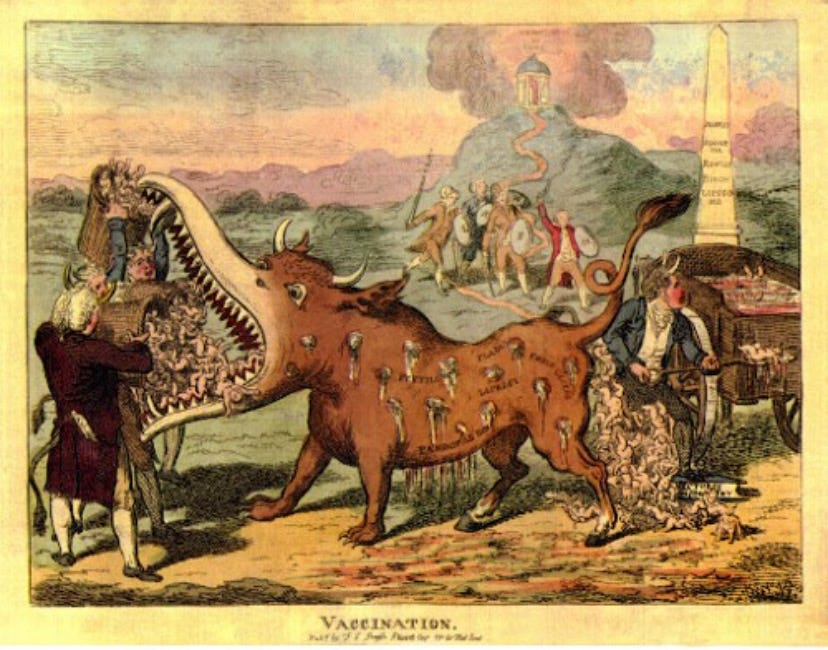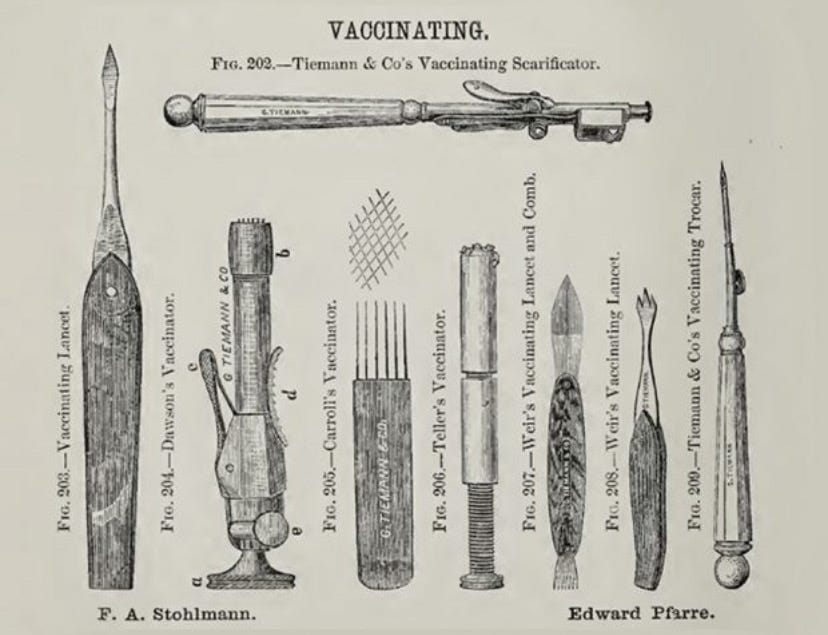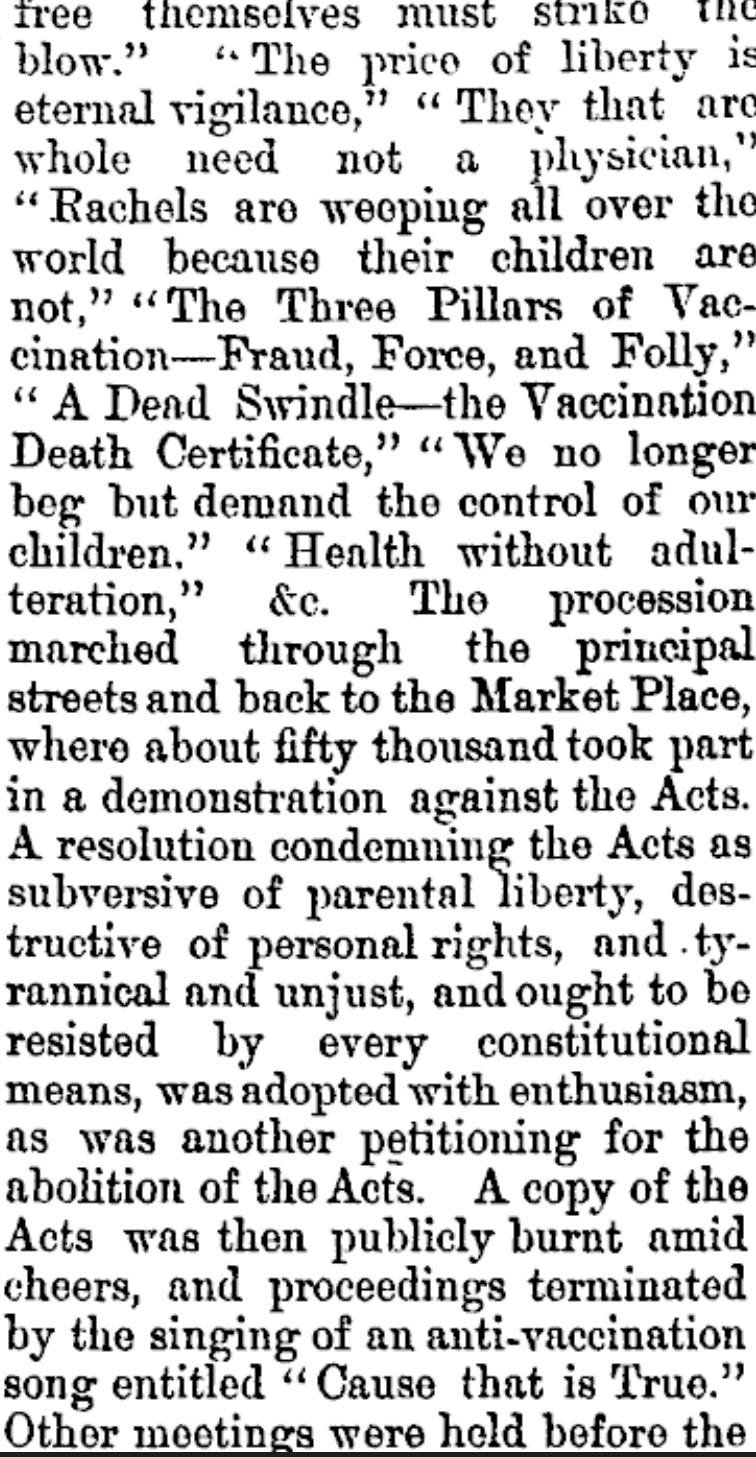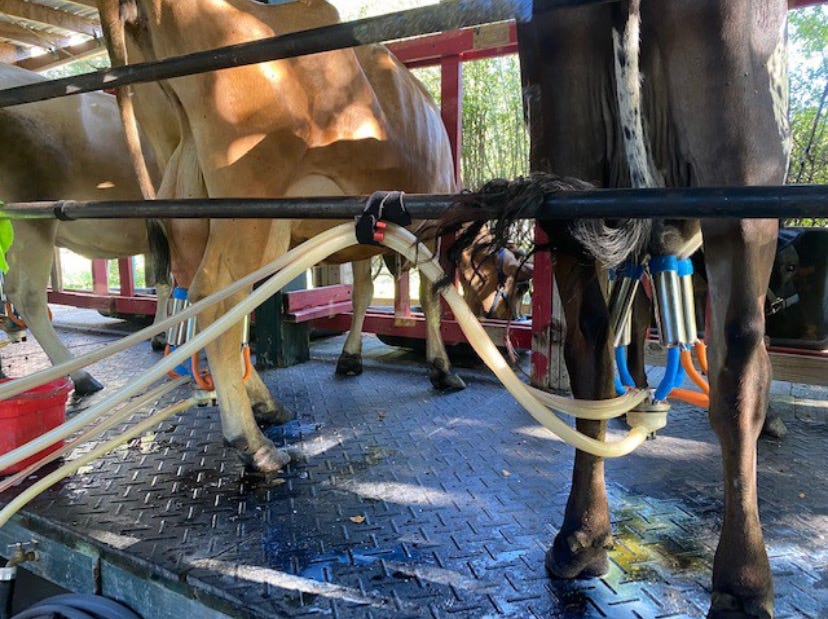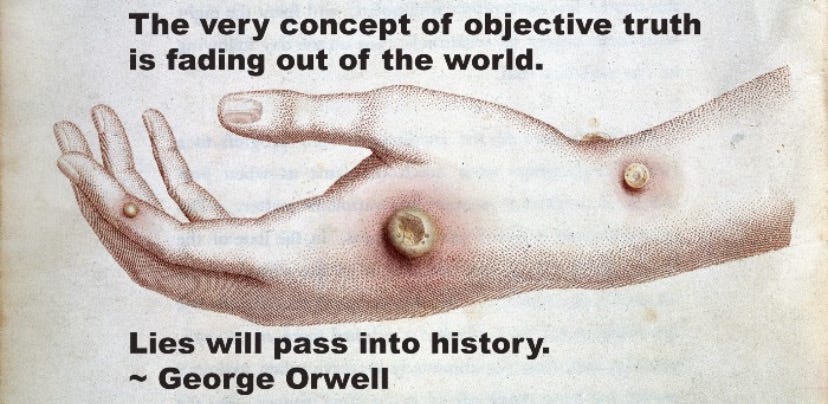THE BIRTH OF VACCINE AND DEATH OF THE SPECKLED MONSTER
The Speckled Monster Caricature (Charles Williams c. 1802, British caricaturist)
The worst pandemic in Europe’s history, the Bubonic Plague (1347–1352), coincided with the Hundred Year War that started between the English and French in 1347. Also known as the Black Death, the disease manifested in different forms — flu-like symptoms (pneumonic), gastrointestinal internal bleeding, (septicaemic) and skin eruptions (bubonic). It purportedly killed between 25 to 200 million people. Electricity, domestic plumbing and sewer systems were virtually non-existent during the Middle Ages. Toothbrushes and toilet paper had not yet been invented. Nor had antibiotics and vaccines been discovered. Yet the pandemic ended to herald the Renaissance Age without modern medicine intervention.
Smallpox was another feared disease said to have existed 3000 years ago. It would start with flu like symptoms including fever, fatigue and headache, and its characteristic pox skin eruptions would emerge days later on the seriously afflicted. Nicknamed the Speckled Monster, it was called Smallpox to distinguish it from the more stigmatized Great Pox known as syphilis and from the less deadly chickenpox (varicella zoster virus). The smallpox virus was named after the Latin word for variola meaning “speckled or spotted”. Variola major was referred to as the deadly strain. However, the milder variola minor (Alastrim) strain commonly associated with ‘modern’ smallpox had significantly lower death rates and was the dominant strain discovered in the late 1800s. Smallpox would nevertheless become the Chosen One to herald the magical potion called vaccine to the entire world.
Prior to vaccines, a technique called variolation had its early roots in Asia and the practice was found as far back as the 11th Century in ancient China. Smallpox scabs ground up into powder were blown into the nose through a tube (intranasal). A primitive form of variola inoculation may also have been practiced by scratching matter extracted from a smallpox sore or pustule into the skin. The aim was to produce a mild case of smallpox that would bestow the inoculated person lifetime immunity. What started out as a natural medical folk practice in Asia and even in Africa eventually spread to Europe and America. Inoculation became a surgical procedure that was lucrative and practiced by some doctors in England beginning 1721. It involved using specialized knives called lancets or scarificators that made several small incisions in the skin of a healthy person to which pus from smallpox victims were transplanted. It was said that George Washington used this method of inoculation to protect his troops during the civil war in 1777. However, its use was controversial and contained inherent risk for spreading the disease, causing injuries or death.
Early Vaccinating Instruments
In 1796, Edward Jenner (1749–1823), a physician from Gloucester, UK who was a specialist in smallpox inoculation became curious about cowpox. It was a common belief or folklore that milkmaids who had cowpox from milking cows did not contract smallpox. Jenner speculated that cowpox was a milder version of smallpox which originated from horses and spread through human contact to cows. In other words, from farriers (blacksmiths) to milkers, from horse feet to cow teat. He researched, experimented and documented 23 cases in his manuscript including his 11-month old son (Case 22). The most often cited case (Case 16-17) was from his published journal “An Inquiry Into The Causes and Effects of Variole Vaccine, Or Cowpox” (1798). He extracted cowpox matter from lesions on the hands of a dairymaid (Sarah Neimes) which she claimed she caught milking a cow (Blossom). He then inoculated them on the arm of a healthy 8-year old boy (James Phipps) who was his gardener’s son. The child became mildly sick and recovered. Jenner later variolated the boy and was satisfied that his cowpox experiment was a success when the boy did not contract smallpox. Convinced that it would be “essentially beneficial to mankind”, he named his product vaccinia (cowpox) or vaccine, a name derived from the Latin word “vacca” which means cow. Jenner after petitioning for renumeration was eventually awarded a total of 30,000 pounds (approx. 2.1 million pounds today) from the British government for his discovery and invention. The procedure took infected material from an animal which resembled cowpox (also horsepox or swinepox), transferred to a human through inoculation via small incisions in the arm and then to another human. Hence, “arm to arm vaccination” was used for about 100 years until it was discontinued in 1898. It replaced the practice of variolation outlawed in 1840. Inoculation, formerly known as variolation would become synonymous with vaccination, ie., injection from non-human originated virus. The word “virus”, another word coined by Edward Jenner, came from its latin name which means poison or slime. [Footnote: The first electron microscope known to detect a virus was not built till 1931].
Vaccination for smallpox started in 1800 and the practice spread throughout Europe and America. The English government did not enforce it until 1840 and 1853 where every child had to be vaccinated within 3 months of birth. The 1867 Vaccination Act in England made vaccination compulsory and instituted a stiff penalty for parents who failed to comply. Non-compliant parents, particularly the poor and working class, who could not afford to pay the fines were criminalized and subjected to loss of goods or imprisonment. In spite of the harsh laws and strict adherence to vaccination, a massive smallpox epidemic in 1870 hit England and other parts of Europe. Revaccination was recommended as a solution to the smallpox epidemic.
Evening Post, Vol XXIV, Issue 108, 5/30/1885
In 1885, people in Leicester, England revolted. Known as the first Anti-Compulsory (Anti-Vax) Demonstration, about 50,000 protestors took to the street to demand repeal of the law, proclaiming “The Three Pillars of Vaccination — Fraud, Force and Folly”. The citizens instead implemented the Leicester Method — isolation or quarantine along with sanitation and hygiene. In the 1891–1894 smallpox outbreak, the highly vaccinated town of Birmingham had 63 smallpox cases and 5 deaths per 10,000 of population compared with Leicester at 19 cases and 1 death per 10,000. In 1898, a new Act was enacted that removed cumulative penalties and introduced a “conscience clause” that allowed exemptions from mandatory vaccination.
The book “Dissolving Illusions” by Dr. Suzanne Humphries uses historical data and statistics hidden from public or common knowledge to detail the waning deaths from infectious diseases including smallpox from the 1800s onwards. They were primarily attributed to public health policies implemented over a period of time in hygiene, sanitation, water supply, housing, food, labor and environmental laws. She pointed out in the chapter Not So Good Ol’ Days, abysmal sanitation, hygiene, nutrition and overcrowded living and working conditions were the main reasons for causing these devastating diseases. The working class majority, including children of all ages (age 4 and up), worked in extreme conditions — “long hours, revolting environments, little rest and poor nutrition” which also took a serious toll on their health. In her chapter, Smallpox and the First Vaccine, she highlighted an 1850 newspaper report that stated “there were more admissions to the London Small-Pox Hospital in 1844 than in the celebrated smallpox epidemic of 1781 before vaccination was introduced”. Newspapers constantly reported deaths from smallpox in properly vaccinated citizens, as well as serious injuries from other conditions like erysipelas (skin infection) after vaccination. It was also claimed other infectious diseases attributed to vaccination included jaundice, tuberculosis and syphilis.
As vaccine demand grew higher so did its mass production. She wrote in the chapter, Vaccine Contamination:
“Vaccine virus was produced on a living calf or heifer. The animal was bound to a table where its belly was shaved. Multiple scratches or cuts were made, into which the seed virus was placed to grow. The animal was released, and the cowpox infections were allowed to incubate. After about a week, infectious pus was extracted from the wounds to be used in smallpox vaccines for humans. The diseased animal was released and allowed to mix back with the herd. Finally, it was slaughtered, and its meat or carcasses were either used or destroyed. Outbreaks of foot and mouth disease in 1902 and 1903 were closely associated with the vaccinated cattle of the New England Vaccine Company’s establishment”.
She concluded, “as long as animals and animal cells are used for vaccine manufacture, the potential for infection will exist”. [Footnote: The SV-40 virus was a known contaminant of polio vaccines grown on monkey kidney cells].
Edward Jenner wrote in his second published journal, Further Observations on the Variola Vaccinae or Cow Pox, that vaccine contamination can arise from not using true cowpox pustules. He had received complaints that certain people who were vaccinated with the cowpox had also contracted smallpox. He raised the possibility that “spurious” (fake) cowpox may come from sick cows that gave out an “OFFENSIVE STENCH FROM THEIR UDDERS” [extracted in verbatim].
Edward Jenner died of a major stroke at aged 73. His son Robert, whom he vaccinated as a baby, was often sick and died at the young age of 21 from tuberculosis. As for Blossom the cow, used in Jenner’s vaccine experiments, it is said her horn lives in his house in Berkeley, Gloucester which has since been converted into a museum, and her giant hide lives at the University of St. George, where Edward Jenner was Alma Mater.
Milking cows at Irish Acres Farm, Brooksville, FL
From time to time, I volunteered and worked for my food at a small farm in Northern Florida known locally for producing the finest raw unpasteurized milk and pure butter. The cows graze on about 10 acres of green organic pasture — no pesticides nor artificial fertilizers are used in the fields. Neither chemical hormones, vaccines nor antibiotics are used on the cows. The cows have ready access to crystal clear water that the region is known for. Dealing with cow patties (poo) can be messy but at this farm they do not smell. Yes, I’ve given all 7 cows’ (Daisy, Lulu, Cocoa, Emma, Lily, Julie and Smokey) udders the sniff test and am sure Edward Jenner would have given them the thumbs up!
I learned to make kefir, yogurt and cottage cheese from fermented raw milk. Milking cows is hard work but modern machinery helps speed up the milking process. In fact, we spend more time washing, cleaning and disinfecting the cows and the facility. Having instant access to a water faucet, hot water and spray hose makes the sanitizing work much more efficient and I am thankful for such modern conveniences, including a nice hot bath after a hard day’s work. I look back to the Not So Good ‘Ol Days when people had to haul buckets of water from a well or river which could be from a very long distance to wash and clean. Boiling big pots of water using firewood must have been a tiring chore. I think of Sarah Nelmes, Jenner’s famous milkmaid and wonder how many cows she had to hand milk a day. I picture her squatting underneath a cow’s udder, squeezing and pulling all 4 cow’s teats for hours to get a few gallons of milk. I think of her poor blistered hand and wonder if she also suffered from carpal tunnel syndrome. FYI, raw milk makes an excellent skin moisturizer. I picture her, otherwise, a healthy girl abundantly nourished from farm fresh food and her glowing skin “as smooth as milkmaid”. I become nostalgic for the Good ‘Ol Days. As mass commercialization of farming takes over, small farms are a dying breed in America. Smallholder farmers all around the world, especially developing countries like India struggle hard to stay alive.
In 1980, the speckled monster would cease to rear its ugly head when WHO declared smallpox eradicated globally. Today, smallpox virus samples are stored for research purposes at 2 WHO designated lab sites — one in Atlanta, Georgia and the other in Siberia, Russia. In 2020, WHO declared Covid19 a global pandemic, a new viral beast for which a new vaccine was fast tracked for emergency use called the mRNA vaccine. For the first time in the history of vaccination, biotechnology was engineered to create a synthetic version of the spike protein of the virus that is said to cause the disease. The mRNA vaccine is seen as a modern, more refined and thereby a safer version than live attenuated (weaker) RNA viruses traditionally grown from animal tissues or cells. Only time will tell if another dreadful monster is lying dormant in the deep abyss.




